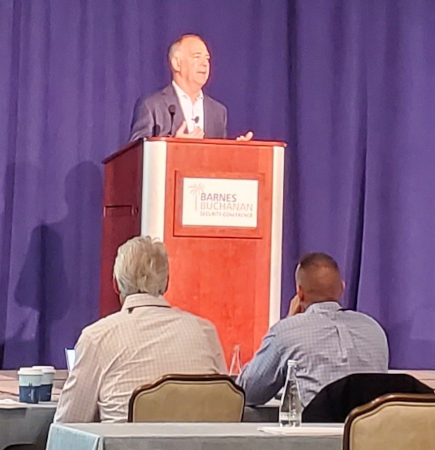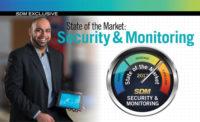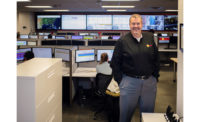Barnes Buchanan, held this year February 9-10 at the Breakers in Palm Beach, Fla., is indisputably the premier conference for discussing the financial side of the security alarm industry. In less than two days the conference manages to pack in a lot of information to process and this year was no exception. The good news is that the big takeaways were mostly positive, in spite of going on year three of a worldwide pandemic, ongoing supply chain issues, a looming recession and inflation issues.
For one thing, lenders still like the security industry. While the amount of capital may be slightly reduced, the interest of both banks and non-bank lenders is still active, said John Robuck, head of the security finance lending business at Capital One, in the first session of the conference, the Lender Panel. “The RMR lending space is a niche product. We are seeing more non-banks getting involved in this space. There continues to be availability of capital, but it is a little different than in past years. The last few months really focused on relationships.”
Nor were the lenders particularly concerned about the possibility of recession. “All during COVID we had an ongoing dialog about how we were reacting to challenges and that has continued,” Robuck said. “We would anticipate if there actually is a recession that there would be some choppiness, but we are not overly concerned about the underlying performance of these businesses. This is a highly demanded industry very well positioned to see it through.”
C.J. Pascarella, senior vice president and corporate banking sales leader for the PNC Financial Services Group, echoed a lack of worry about recession. “The most downside talk is a 5 percent unemployment. It will probably be pretty mild if things do slow.”
Day one of the conference also featured company presentations from current and past SDM Dealers of the Year Melissa Brinkman of Custom Alarm (2022 winner) and Joey Rao-Russell of Kimberlite (2020 winner), and a panel discussion the future of the industry – 2028 and beyond. Read more about that here.
But the main event, and a large part of why the Barnes Buchanan conference has been going strong for 28 years and counting, was day two’s annual presentation on the alarm industry market overview and update, presented by Michael Barnes, founder of Barnes Associates and director of the firm’s mergers and acquisitions activities.
Barnes had quite a bit of good news to share, tempered with some caution and a few threats to be aware of.
Overall the industry did very well in 2022, with record results from a number of companies. Combined revenue from installation and monitoring and service was up 6 percent in 2022 over 2021 and Barnes estimated the total industry revenue at $69 billion, with about a 50/50 split between installation revenues and RMR and service revenues.
He, too, was unconcerned about a potential recession, reminding attendees that this industry is generally recession resistant.
“[During recessionary periods] the underlying recurring revenues have always increased, because even though the installation activity shrinks, it is still enough activity to not only replace real attrition but also cause slight growth,” he explained. “That will be true if we do get this recession everyone is talking about. If we see anything at all, installation revenue will contract a bit while service and monitoring will continue to grow.”
Looking at commercial and residential segments separately, Barnes said the commercial segment on average is growing faster than residential. Technology-wise, the strongest growth was in the video surveillance (14 percent), smart home (15 percent) and PERS (15 percent) systems. While DIY was once feared as a potential threat, Barnes said DIY, which also enjoyed 15 percent growth and makes up about 7 percent of the market, is now “just a fabric of the industry. It didn’t disrupt but instead became a nice additional offering and another way for consumers to get their hands on the system.”
Across the market, growth drivers remain strong, Barnes said, citing that alarm systems work, are increasingly getting insurance industry and regulatory support (particularly with ADT’s new partnership with State Farm), and technologies are improving and broadening the market.
“You can just feel the optimism,” he said, “[from] the level of technology, [to] the applications, [to] the skill of alarm companies.”
That said, there has been and continues to be consolidation due to mergers and acquisitions, particularly for the small alarm dealers.
“Is the industry heading towards a big consolidation? It used to be I would answer no,” Barnes said. “Historically we would see regional and local players actually gain market share because they would grow faster than the industry rate. Now we can safely say that is not what is going on anymore. There is inevitably going to be a shrinkage in the smaller, local share of the market. National companies have dialed it in. Vivint and ADT are perfectly poised to do that now and they are achieving higher growth rates. The other big factor is it is a lot harder to operate a company now. The suppliers, the technology and training are just harder as a small company.”
Overall the market share by RMR of local dealers has gradually slipped from 35 percent in 2013 to 28 percent in 2022.
BUT, he added, “Don’t write them out. That segment is not going away. They are way too good in so many things.”
Barnes cited the emergence of wholesale monitoring and the trend towards using those services rather than trying to maintain an in-house central station as one way smaller dealers continue to compete. He also mentioned an ongoing shift towards developing expertise in commercial markets, which are growing faster.
When it comes to RMR, Barnes estimated that it costs the industry on average $28 to originate $1 of RMR. “The vast majority of the industry in RMR is barely breaking even and most are losing money,” he said. Margins have slipped over time from about 54 percent in 2013 to 51 percent in 2022.
“What is not causing that is that monitoring costs are going up,” he added. “The average signal gets handled at a much cheaper cost.” Contributing factors include additional services that dilute the margins, increasing overhead, underlying labor costs and price shifting towards higher installation fees.
But the good news is gross attrition is down, with security subscribers from 2021 to 2022 less likely to switch providers.
For both installation and RMR, Barnes urged attendees to consider raising prices, even though it may be hard.
“The industry needs to wake up and realize you can and should charge for that system,” he said. “When you put that state-of-the art system in, that is real value and you should be able to charge for that rather than deep discounting.”
One of the biggest threats to the industry right now is inflation, he added. “The challenge with inflation is costs are going up and we need to become more efficient and reduce relative costs, or increase prices. But keep in mind 50 percent of the industry’s revenue is in the recurring revenue.
 Mike Barnes of Barnes Associates delivers the alarm market industry overview and update at the Barnes Buchanan Conference in February, 2023. | IMAGE COURTESY OF SDM STAFF
Mike Barnes of Barnes Associates delivers the alarm market industry overview and update at the Barnes Buchanan Conference in February, 2023. | IMAGE COURTESY OF SDM STAFF“It’s easier for people to wake up on a Monday and decide to raise installation fees. It is not easy to do, but companies are more natural in responding to that. The harder part is the other half, the billions under recurring revenue contracts. How do you price increase that? It is not easy, but I am here to tell you, in our estimation, you’ve got to do it.”
He suggested reminding the end user about the highly valuable services you offer, but now you need to charge more. “We are strongly recommending to everyone that you go back, swallow hard, and do some price increases. Your competitors are probably doing this, and you deserve it. It is also good because you have to refine your ability to do it. Our future is likely to include more volatility around inflation so you need to figure out how and when to do it.”
Another big threat, which has been the case for the past several years, is operating complexity. “It is just more difficult to run an alarm business these days,” Barnes said. “This is the biggest threat. It is too much, too fast. [Small dealers, particularly] can’t keep pace with technology and supply chain, hire and train effectively and don’t have scale. We see that threat continuing.”
As noted by the lenders on the first day, Barnes echoed that while market values are aggressively up and historically high and lots of deals are getting done, any transaction in the deal market now is just a little tougher now to get done. “It can be challenging and fragile. I still feel like it won’t take a lot for the gas to come out of the balloon a bit.”
He also clarified that while if may feel like the market is crazy with transactions right now, historically it is about average. “The market is trading rationally and consistently,” he said.
Where does all that leave the security alarm market going forward?
“We don’t normally come with a crystal ball,” Barnes said. “I would have told you last year we were generally optimistic but it was still a challenge with labor disruptions, etc. I would never have predicted market values would have moved as hard as they did.”
While reluctant to prognosticate for 2023, Barnes did say this: “From an industry-specific perspective, I don’t see anything changing. The buyers in 2022 that were very active are still there and recharged with money. There are plenty of sellers and good transactions will happen. The biggest threat is whether the industry can maintain those metrics given inflation.
“The industry remains a good place to be at all levels. We see some of the best performance metrics coming out of the smaller companies. The technologies coming down the road are truly going to be transformative,” he added.







